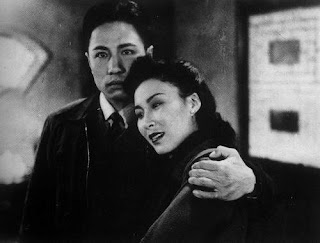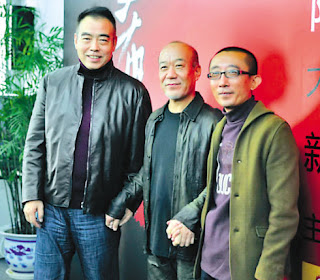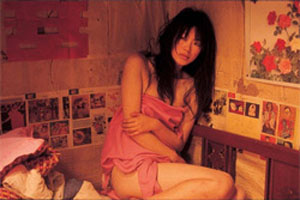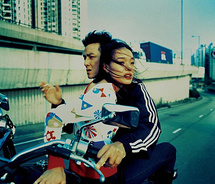 | |
| Street Angel 马路天使 directed by Yuan Muzhi 袁牧之, 1937 |
Mainland Cinema
1916 saw the Hui Xi production company’s first fully locally-funded effort with Wronged Ghosts in an Opium Den 黑籍冤魂, followed in 1922 by Romance of a Fruit Peddler (劳工之爱情 a.k.a. Laborer’s Love ), a light comedy and the earliest Chinese film to survive until today.
 |
| Romance of a Fruit Pedlar, a.k.a. Laborer’s Love 劳工之爱情, 1922 |
Early Chinese films were mostly entertainment-based, and consequently given a poor write-up by historians as such, though in more recent years scholars have taken a second look to find much sophistication in that era’s offerings. Nonetheless, in the 1930’s Japanese aggression prompted more political, progressive films, sparking what came to be known as China’s first Golden Age of film, the resistance cinema of the 1930’s, specifically 1932-7. Those years included Spring Silkworms 春蚕 (a 1933 adaptation of a Mao Dun 茅盾 short story), one of the earliest of the “leftist” cinema; Sun Yu’s 孙瑜 Big Road (大路 a.k.a. The Highway) in 1935; and in 1937, Street Angel 马路天使 directed by Yuan Muzhi 袁牧之.
1937 brought the outbreak of full war with Japan, bringing local, free cinema almost to a complete stop; however, Japan fully promoted the cinema industry under occupation, and it thrived as such, albeit in a heavily censored form, pushing Chinese filmmakers to disguise their anti-Japanese slogans by sometimes thinly veiled methods. Then, from 1946-1949 a “second Golden Age” of Chinese cinema emerged, mostly focusing on hardships of the civil war period. This included 1947/1948’s A Spring River Flows East 江春水向东流, sometimes referred to as “China’s Gone with the Wind”. Also released in 1948 was Spring in a Small Town 小城之春, directed by Fei Mu 费穆, later named by the 2004 Hong Kong Film Awards as the greatest Chinese language film ever made. It’s fate was to be criticized and banned by the Communist government, only to enjoy a revival in the post-Cultural Revolution era.
 | |
| Spring in a Small Town 小城之春, directed by Fei Mu 费穆, 1948 |
In October 1946, the Northeast Film Studio 东北电影制片厂, located in Hegang (north of Ha’erbin), took over production from the confiscated Japanese Manchuria Cinema Association 満洲映画協会, and released its first feature, Bridge 桥, in May of 1949. The studio would later reshape and relocate to become the famous Changchun Film Group Corporation 长春电影集团公司. Later works focused largely on women as heroine fighters, workers, martyrs and sufferers, a trend of perhaps misplaced feminist sentiment that would last right on into the 1980’s, the next period of Chinese cinema to really leave a mark for itself.
The period from 1949-1966 was almost completely dominated by Socialist-Realist “worker-peasant” films (工农兵电影). In 1951 all pre-1949 Shanghai films were banned, as were foreign and Hong Kong films. 1956 was an important year, in that it saw the inauguration of the Beijing Film Academy 北京电影学院, the origin of so many of the country’s soon-to-be screen legends.
The government takeover of film began with the reaction against Sun Yu’s 孙瑜 1950 film The Life of Wu Xun 武训传, which was viciously criticized by Mao, signaling the takeover of private cinema by the government’s department of Propaganda and later the Ministry of Culture. Within the promotion of “revolutionary realism”, various sub-genres emerged, including village films, national minority films, spy/espionage films, revolutionary/war films, films with industrial subjects and adaptations of May 4th literature.
During the 100 Flowers Movement (1956-1957), state-control of cinema was somewhat relaxed, and new techniques and themes emerged, including criticism of Communist bureaucracy and heavy-handiness, only to be cracked down on again in the Anti-Rightist movement. The Great Leap Forward brought a push for more production (at fewer costs—resulting in crude, hurried productions), and later the 10-year anniversary of the PRC yielded a state-sponsored improvement in production techniques.
 |
| director Xie Jin 谢晋 |
1960-1966 is referred to as the Classical revolutionary period, the films of which are often called simply “red films”. The important director Xie Jin 谢晋 captures the context of the era. As Esther Yau writes,
“Xie Jin, who emerged as a new talent in the late 1950s, demonstrated exemplary skills in adapting traditional and Hollywood type narrative and characterization strategies to revolutionary contexts. His military film Red Detachment of Women ([红色娘子军], 1960) incorporated thriller-type elements and exploited the ‘exotic’ details of southern China; while Stage Sisters ([舞台姐妹], 1964) was a finely crafted, melodramatic character study of two female opera singers.”
 |
| Three Monks 三个和尚, 1980 |
Animated films using a variety of folk arts, such as paper cuts, shadow plays, puppetry and traditional paintings, also were very popular for entertaining and educating children. The most famous of these, the classic Havoc in Heaven 大闹天宫 (in two parts, 1961 and 1964), was made by Wan Laiming 万籁鸣 of the Wan Brothers 万氏兄弟 and won Best Film award at the London International Film Festival. Additionally, two animated ink and wash films (水墨动画片), Where is Mama? 小蝌蚪找妈妈 (1960) and The Flute of the Cowherd 牧笛 (for the second half, click here), co-directed by the classic Chinese animator Te Wei 特伟 in 1963, captured the art and poetry of Chinese brush painting.
During the Cultural Revolution, cinema production was stopped except for ten revolutionary opera 革命样板戏 films (including Taking Tiger Mountain by Strategy 智取威虎山, heavily controlled by Mao’s wife, Jiang Qing), and older films were pulled from circulation, while many writings on cinema were destroyed.
 |
| Taking Tiger Mountain by Strategy 智取威虎山, 1970 |
After 1973, film production slowly resumed, and in 1981 China began the Golden Rooster Awards 金鸡奖 for film. The period between 1977-1984 was marked by “scar films” 伤痕电影, part of a wider artistic movement dealing with the Cultural Revolution’s effects on society, at the same time more or less ending the eulogization of peasant workers at the expense of intellectual characters, most notably, perhaps, in Xie Jin’s Hibiscus Town 芙蓉镇 in 1986.
1984 marked the start of a new chapter, in which Wu Tianming’s 吴天明 Life 人生 began a new era of modern films that focus on the individual, along with Lu Xiaoya’s 陆小雅 Girl in Red 红衣少女 about an inquisitive high school teenager. The switch to a market economy that was slowly integrated into the movie industry resulted in both more freedom for movie makers, and less ability to continue the exploratory techniques of the early 80’s, as an audience-based direction for funding necessitated the increase in popularism to the detriment of artistic experimentation.
 |
| directors 张艺谋 and 陈凯歌 |
Zhang Junzhao 张军钊, working with cinematographer Zhang Yimou 张艺谋, in 1984 made One and Eight 一个和八个, which moved cinema beyond the then popular “human realism” toward new themes, via a multitude of new techniques. Zhang Yimou also worked with director Chen Kaige 陈凯歌 on Yellow Earth 黄土地 in the same year. Underappreciated until it received immense praise at the Hong Kong International Film Festival, it is now among the most well known Chinese films in the world. Finally, Tian Zhuangzhuang 田壮壮"shunned Han enthnocentrism" by focusing on Mongolian culture in 1985’s On the Hunting Ground (猎场扎撒) and 1986’s Horse Thief (盗马贼).
All graduates of the Beijing Film Academy from the same year, these directors and cinematographers became known as the Fifth Generation of Filmmakers, often described as “exploratory (tansuo 探索)” in technique and austere in approach, also acknowledging their general failings in the box office, despite critical acclaim. Ester Yau writes,
“the Fifth Generation movement enforced a rupture between itself and the types of realism so far established. In relentlessly dismantling the language and ideology of an established political culture, the Fifth Generation films renounced the dramatic patterns of both revolutionary and humanist realism; instead, their narrative and formal strategies were critique-oriented. (p. 700)”
However, it wasn’t until Zhang Yimou made the switch to director, combining the more arthouse technique of the Fifth Generation with tales of passion and romance that were more accessible to audiences, that modern Chinese film became more popular at home.
 |
| Yellow Earth 黄土地,directed by Chen Kaige 陈凯歌, 1984 |
The label “Fourth Generation” retroactively refers to the older directors, et al. working in the 1980’s who had received their training before 1966, whose careers had been disrupted by the Cultural Revolution, and whose outlook was more humanist than their austere younger counterparts. Often focused on women figures struggling in the transition between traditional and modern China (e.g. Huang Jianzhong’s 黄健中 A Good Woman 良家妇女in 1985, and Wu Lan’s 乌兰 1986 film, Girl from Hunan 湘女萧萧), in many of these films, “sexual love has a redemptive value, as it is expressive of individuality and desire to change. (Yau, p.701)”
 |
| Gong Li in Zhang Yimou's Red Sorghum 红高粱, 1988 |
These directors were able to produce their films largely because of the work of Xi’an’s film studio under the guidance of director Wu Tianming 吴天明, who stated his goal as “to make profit with one hand and take awards with the other”, thus balancing exploratory and popular film, culminating in Zhang Yimou’s Red Sorghum 红高粱 taking home awards from Berlin in 1988. Then, toward the end of the 80’s, films began to center on life in the cities and Chinese citizen’s ambivalence in a new commodity-driven market economy, especially those films made in Guangdong’s Pearl River Studio.
At this time approximately 20 female directors became active in the male-dominated industry, including Lu Xiaoya 陆小雅, Zhang Nuanxin 张暖忻 , Huang Shuqin 黄蜀芹, Wang Junzheng 王君正 and Li Shaohong 李少红, focusing on the tension between tradition and modernism, including the sexual liberation of women in Chinese society. One such film was Huang Shuqin’s second, 1993’s Huahun (画魂 a.k.a. A Soul Haunted by Painting a.k.a. La Peinteur, starring Gong Li 巩俐) , which was heavily censored for its scenes of sex and nudity.
In the 90’s, especially in the government’s conservative backlash after the Tiananmen Massacre, there was more pressure to commercialize, especially as the market for film audiences came under pressure from American and Hong Kong videos, among other things. Also at this time, the CCP began producing and funding epic historic films in attempts to strengthen its image and shape historical narrative, a trend still seen today.
In the 90’s, especially in the government’s conservative backlash after the Tiananmen Massacre, there was more pressure to commercialize, especially as the market for film audiences came under pressure from American and Hong Kong videos, among other things. Also at this time, the CCP began producing and funding epic historic films in attempts to strengthen its image and shape historical narrative, a trend still seen today.
| the director Huang Shuqin 黄蜀芹 |
Meanwhile, a discreet and lo-key documentary movement grew out of the Academy of Broadcasting, including 吴文光Wu Wenguang’s Bumming in Beijing (流浪北京 1988) about struggling artists in the nation’s capital. Others focused on the lingering impact of the Tiananmen Square protests.
Without access to the studio funding that the Fifth Generation directors enjoyed (many of whom in the late 90’s were becoming international stars in European film festivals), the so-called Sixth Generation of filmmakers have had to independently finance their own features, luckily without the pressure of studio quotas. In comparison, their films about disillusionment and isolation make the works of Chen Kaige and Zhang Yimou seem commercial in comparison. (As illustration, Jia Zhangke’s Still Life 三峡好人 was released in 2006, two years after Zhang Yimou’s House of Flying Daggers 十面埋伏, and one year after Chen Kaige’s The Promise 无极.)
 |
| The World 世界, directed by Jia Zhangke 贾樟柯, 2004 |
This generation is best known by directors Jia Zhangke 贾樟柯, Wang Xiaoshuai 王小帅 and Zhang Yuan 张元 , whose 1993 Beijing Bastards 北京杂种 was one of China’s first independent films, starring musicians Cui Jian, Dou Wei and He Yong. Li Yang 李杨 is particularly well known for his brutal treatment of modern Chinese social problems, such as the female sex trade (2007’s Blind Mountain 盲山) and the dangerous and corrupt mining industry (2003’s Blind Shaft 盲井). Zhang Yuan was one of the first mainland directors to openly explore the themes of homosexuality in East Palace, West Palace 东宫西宫 (1996), and Lou Ye 娄烨 is known for his neo-noir treatments of sexuality, obsession and gender, e.g. Suzhou River 苏州河 (2000), which is still banned in China. Other notable directors include He Jianjun 何建军 and Lu Chuan 陆川, the latter of whom is loosely grouped into the Sixth Generation less for common themes than for chronological purposes.
More recent developments in Mainland film include the extremely low-budget and independent dGeneration (d for digital), and the New Documentary Movement, which goes back to Wu Wenguang’s Bumming in Beijing mentioned above. Meanwhile, in the last decade filmmakers Feng Xiaogang 冯小刚 and Jiang Wen 姜文 have made popular films that have done extremely well in the local box office. Feng’s Aftershock 唐山大地震 (2009) and Jiang’s Let the Bullet’s Fly 让子弹飞 (2010) grossed 97.4 million dollars and 111 million, respectively.
 | |
| Blind Mountain 盲山, directed by Li Yang 李阳,2007 |
-----------------------------------------------------------
Taiwanese “New Cinema”
Early on, largely making kung fu and action epics (which many times rivaled those of Hong Kong), Taiwanese cinema later came to be defined by directors such as Hou Hsiao-hsien 侯孝賢, Tsai Ming-liang 蔡明亮 and Edward Yang 楊德昌.
 | |
| the director Edward Yang 楊德昌 |
Early Taiwanese cinema was dominated by the themes and styles of its Japanese occupiers, notably including the narrated silent-film genre, benshi (弁士), renamed benzi in Mandarin. After the Chinese civil war, and the arrival of the Kuomintang, most films between 1949 and the mid 1960’s were made in Taiwanese. The KMT’s policy of promoting Mandarin, and for a time outlawing Taiwanese, led to a quick decline, with the last entirely Taiwanese-language film made in 1981. Then in 1963, the government introduced the “Health Realism” movement, which strove to implement societal morals through cinema.
In the late 1970’s, seeking to distinguish itself from mainland China, Taiwan launched a “back-to-roots” cultural exploration that gave rise to the “New Cinema” movement of the 1980’s. The emergence of hsiang-t’u (郷土: nativist) art, following the expulsion from the U.N., the denial of participation in the Olympics, and the severance of diplomatic ties with many nations, sparked an introspection breaking with the tradition of mainland exile literature, Western-influenced elite styles, or popular commercialism that had thus far dominated the island.
 |
| City of Sadness 悲情城市, directed by Hou Hsiao-hsien 侯孝賢, 1989 |
The movement in film began with 1983’s The Sandwich Man 兒子的大玩偶 (a.k.a. His Son’s Big Doll), adapted from Huang Ch’un-ming’s 黃春明 novellas, and In Our Time 光陰的故事, a 1982 film directed by Edward Yang, Te Chen-tao, I Chen-ko and Yi Chang. The films, among other things, explore the socio-economic life of country people, as well as poor urban-dwellers, in Taiwan’s changing society.
Most of the directors of the era were educated in film schools in the U.S.; however Guangdong-born Hou Hsiao-hsien, who fled the mainland with his family after 1949 and grew up with the modernization of the once agriculturally-based island, is one of the few to have not lived abroad.
After three commercial films, in 1983 he made His Son’s Big Doll, in which he began to develop a characteristic style of “a laconic and oblique story-teller, downplaying the dramatic by offering leisurely observations of small, everyday occurrences. He favours meditative long takes with a minimum of camera movements, most often in medium or long shot. A favourite technique is to allow the camera simply to stare at an empty room that a character is about to enter or has just left, frequently making masterful use, through the soundtrack, of off-screen space…. His cinematic style has been compared to classical Chinese poetry, to traditional landscape painting, and to Buddhist narrative scrolls. (Yip, p. 712)” Hou’s 1989 epic City of Sadness 悲情城市 launched him to international acclaim at foreign film festivals, cementing his reputation as the voice of Taiwanese cinema.
 | |
| Eat, Drink, Man, Woman 飲食男女, directed by Ang Lee 李安, | 1994 |
Films of the 90’s and beyond became gradually more accessible to audiences, while retaining much of the themes and styles of the earlier New Wave movement. Tsai Ming-Liang’s 1994 Vive L’Amour 愛情萬歲 explores the life of Taipei’s urban youth, for example. However, Ang Lee 安李 is the best known of what is informally called the “Second New Wave”, making films with strong family themes that were praised by both critics and the average movie-goer, beginning with his early films Pushing Hands 推手 (1991), The Wedding Banquet 喜宴 (1993) and Eat, Drink, Man, Woman 飲食男女 (1994). His 2000 wuxia film Crouching Tiger, Hidden Dragon 臥虎藏龍 popularized for the first time Asian cinema outside Hong Kong among common Western audiences, while at the same time setting off debates in academia on its place among traditional Asian cinema (with its international cast and affected themes that seemed fabricated for Western audiences).
In the late 90’s, Taiwanese cinema took a sharp decline, with box office numbers for domestic films dwindling almost to nothing. It was not until Wei Tu-sheng’s 魏德聖 2008 polylingual romantic/comedy/music-drama Cape No. 7 海角七號 that any native film enjoyed wide success with audiences, setting off a revival of optimism for the island’s production. (It is the second-highest grossing film in Taiwanese history, just behind the U.S.’s Titanic.)
 |
| The actress Shu Qi 舒淇 in 蔡明亮Tsai Ming-liang's 2001 Millenium Mambo 千禧曼波 |
References
Berry, Chris. “China Before 1949”, in The Oxford History of World Cinema. edited by Geoffrey Nowell-Smith, Oxford University Press, 1996.
Li, Cheuk-To. “Popular Cinema in Hong Kong”, in The Oxford History of World Cinema. edited by Geoffrey Nowell-Smith, Oxford University Press, 1996.
Yau, Esther. “China After the Revolution”, in The Oxford History of World Cinema. edited by Geoffrey Nowell-Smith, Oxford University Press, 1996.
Yip, June. “Taiwanese New Cinema”, in The Oxford History of World Cinema. edited by Geoffrey Nowell-Smith, Oxford University Press, 1996.
various wikipedia articles accessed between October 28th and November 13, 2011.
viewing wish list:
Bumming in Beijing
The Missing Gun (Lu Chuan)
anything by Wang Bing
